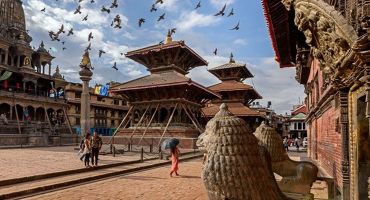The Avaran (built of solid stones) style of temple construction only began after the Lichhavis came to power in Nepal. The temples preceding this form i.e during the Kirata era, were usually rectangular and constructed in brick and wood. This has been mentioned in the Lichhavi King Amshuverma’s inscription LXXVI as translated by D.R Regmi. It says,
‘’Now that we have repaired carefully in the temple of Matin……all the worn out wood…………which had been entirely destroyed by mice and mongoose that had attacked the building had fallen through the crevices..’’.
The use of the word ‘Matin’ is of particular significance here. It usually refers to the Mother Goddess and seems to have inspired the name ‘’Matilam Ksetra’’ almost upto 1497A.D, today clearly named Mahalaxmi Dyochhe by the Newars. Many of these rectangular shaped temples of the Kirata era were renewed during the late Malla era.

Historians believe that most of the early Kirata images of their deities were built out of wood and mud. Some of the ritual practices seen in medieval Kathmandu indicate that they could have also used boiled rice to build images. During the last stages of the Kirata rule, for more permanency the Kiratas had begun making terracotta figurines.
A Lichhavi inscription-XLVIII says,
“matarah sthapita asanmrinmayastah kalakramena chirantanayati vishirnna bhagnapatita panipada jata..” meaning that the replacement images were carved in stone to assure a longer life.
The important aspects of the religion of the Kirata era did not actually end with the reign of the Kiratas in the Kathmandu valley. The later Hindu Kings did find a number of questionable stones that dated back to the Kirata era. Unknown as to what those stones might have been, the larger ones became the Shiva Linga and the smaller ones became manifestations of the Kumari. The ancient places of Kirata ancestor worship became Ajju and Ajima shrines.

But among all the deities still worshipped today in Kathmandu, an important one for us to consider is the Rato Machhendranath located at Bungamati, Lalitpur. Named after Bungayumi during the Lichhavi times, this mother Goddess could be a direct representation of Sumnima during the ancient Kirata times. Machhendranath is taken as a female entity associated with providing a spring source by making a hole in the ground to avert famine through irrigation.





Leave a Reply